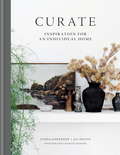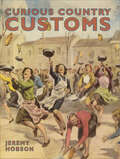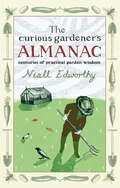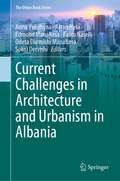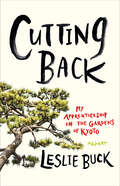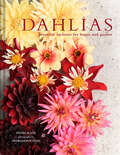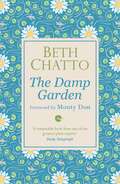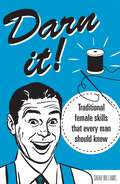- Table View
- List View
The Culture of Cultivation: Recovering the Roots of Landscape Architecture
by Raffaella Fabiani GiannettoBy seeking to rediscover the profession's agricultural roots, this volume proposes a 21st-century shift in thinking about landscape architecture that is no longer driven by binary oppositions, such as urban and rural; past and present; aesthetics and ecology; beautiful and productive, but rather prioritizes a holistic and cross-disciplinary framing. The illustrated collection of essays written by academics, researchers and experts in the field seeks to balance and redirect a current approach to landscape architecture that prioritizes a narrow definition of the regional in an effort to tackle questions of continuous urban growth and its impact on the environment. It argues that an emphasis on conurbation, which occurs at the expense of the rural, often ignores the reality that certain cultivation and management practices taking place on land set aside for production can be as harmful to the environment as is unchecked urbanization, contributing to loss of biodiverstiy, soil erosion and climate change. By contrast, the book argues that by expanding the expertise of design professionals to include the productive, food systems, soil conservation and the preservation of cultural landscapes, landscape architects would be better equipped to participate in the stewardship of our planet. Written primarily for landscape practitioners and academics, cultural and environmental historians and conservationists, The Culture of Cultivation will appeal to anyone interested in a thorough rethinking of the role and agency of landscape architecture.
The Culture of Cultivation: Recovering the Roots of Landscape Architecture
by Raffaella Fabiani GiannettoBy seeking to rediscover the profession's agricultural roots, this volume proposes a 21st-century shift in thinking about landscape architecture that is no longer driven by binary oppositions, such as urban and rural; past and present; aesthetics and ecology; beautiful and productive, but rather prioritizes a holistic and cross-disciplinary framing. The illustrated collection of essays written by academics, researchers and experts in the field seeks to balance and redirect a current approach to landscape architecture that prioritizes a narrow definition of the regional in an effort to tackle questions of continuous urban growth and its impact on the environment. It argues that an emphasis on conurbation, which occurs at the expense of the rural, often ignores the reality that certain cultivation and management practices taking place on land set aside for production can be as harmful to the environment as is unchecked urbanization, contributing to loss of biodiverstiy, soil erosion and climate change. By contrast, the book argues that by expanding the expertise of design professionals to include the productive, food systems, soil conservation and the preservation of cultural landscapes, landscape architects would be better equipped to participate in the stewardship of our planet. Written primarily for landscape practitioners and academics, cultural and environmental historians and conservationists, The Culture of Cultivation will appeal to anyone interested in a thorough rethinking of the role and agency of landscape architecture.
The Cultured Landscape: Designing the Environment in the 21st Century
by Sheila Harvey Ken FieldhouseThis book poses important philosophical questions about the aims, values and purposes of landscape architecture. The editors, highly regarded in their field, have drawn together a distinguished team of writers who provide unique individual perspectives on contemporary themes from a wide base of knowledge. Altogether, this key international study raises awareness of the landscape and encourages innovative ways of thinking about quality in design.
The Cultured Landscape: Designing the Environment in the 21st Century
by Sheila Harvey Ken FieldhouseThis book poses important philosophical questions about the aims, values and purposes of landscape architecture. The editors, highly regarded in their field, have drawn together a distinguished team of writers who provide unique individual perspectives on contemporary themes from a wide base of knowledge. Altogether, this key international study raises awareness of the landscape and encourages innovative ways of thinking about quality in design.
Curate: Inspiration for an Individual Home
by Lynda Gardener Ali Heath***"This gorgeous book marries inspirational ideas with real interiors, to help you curate a home that reflects your personal story and style." Kate Watson-Smyth of Mad About The House"Helpfully divided into eight key elements that bring a space to life, this beautifully photographed book by Australian interior designer Gardener and journalist Heath, makes the perfect accompaniment to a house refresh." Elle Decoration "A paradise for the curious, Lynda and Ali present an interior perspective so cosy that you already feel you live there. Textural spaces cleansed in monochromatic hues - with ideas that invite your imagination to consider home and collections in a new light." Martyn Thompson - Designer, Photographer, Creative DirectorDoyenne of the unique and decorative, Australian interior stylist and boutique hotelier, Lynda Gardener, is always on the hunt for finds to enhance her homes and decorating projects. Her ability to curate and display these personal treasures has created a trademark style that is loved internationally.Curate, the highly anticipated book by creative duo, Lynda Gardener and journalist and stylist Ali Heath, reveals how to create a home that is truly individual. With their shared love of a monochrome aesthetic and natural imperfections, they explore the eight Elements that bring a space to life: palette, nature, textiles, lighting, a combination of old and new, storage, collections and art. Ten aspirational homes show the style in practice, including a converted warehouse, one-bedroom studio, bijoux apartment, historic cottage, country estate, new-build barn, remote shack, period townhouse and rural retreat.With gloriously evocative photography and plenty of down-to-earth ideas, Curate will encourage the reader to embrace their individual style, dream big and create a timeless interior of their own.
Curious Country Customs
by Jeremy HobsonBritain's many traditions have long been one of its greatest attractions; some are extremely famous, but other more weird and wonderful customs are not so well-known and these are often the most fascinating, intriguing and amusing. Organized by month, nearly 100 customs from all over the UK are described and their history and purpose explained. For those who want to take their curiosity a little further, the date and location of each event is given, and there is a section at the back of the book listing the contents by region to allow readers to find out if they can experience the events for themselves either by watching or participating.
The Curious Gardener
by Anna PavordIn The Curious Gardener, Anna Pavord brings together in 12 chapters - one from each month of the year - 72 pieces on all aspects of gardening. From what to do in each month and how to get the best from flowers, plants, herbs, fruit and vegetables, through reflections on the weather, soil, the English landscape and favourite old gardening clothes, to office greenery, spring in New York, waterfalls, Derek Jarman and garden design, Anna Pavord always has something interesting to say and says it with great style and candour.The perfect book to guide you through the gardening year and, on days when the weather keeps the most courageous gardener indoors, the perfect book to curl up with beside the fire.
The Curious Gardener's Almanac: Centuries Of Practical Garden Wisdom
by Niall EdworthyThe Curious Gardener's Almanac contains over 1000 entries of remarkable information about flowers, vegetables, fruits, trees, herbs, insects, birds, water, soil, tools, composts, climate, recipes, gardens and gardeners, myths, superstitions, biodynamics..In short it is a collection as profuse and variegated as gardening itself. Woven into this wealth of knowledge are famous quotations, anecdotes, traditional sayings, lines of verse, and words of rural wisdom. The spirit and focus of the Almanac is British but the wider picture is international as so much of our gardens originated from overseas.Dry or dull information has no place in the almanac and its presentation is as appealing as the content.
Current Challenges in Architecture and Urbanism in Albania (The Urban Book Series)
by Anna Yunitsyna Artan Hysa Edmond Manahasa Fabio Naselli Odeta Durmishi Manahasa Sokol DervishiThis book aims to provide a cross-sectorial assessment in a multidisciplinary and trans-cultural context onto the innovations in urban and architectural approaches in designing next human environments within the Albanian context. The continuous concentration of the world population in the urban areas and their consequent densification require even more quantity of quality spaces and places, integrated resources and energies, alternative modalities of mobility and transports, demand of social inclusion and need for a circular economy. These have become the major challenges for this 21st Century and some of the greatest problems facing humanity in most of current vision for the future. The main objective is to feed a debate about the emerging trans-cultural (and trans-national) approaches in the whole designing field, from Albanian context and its current good practices, attempts and faults, both formal and informal. Thus, the Albanian experience may represent an opportunity through which we all may reflect about how designing is evolving in the Mediterranean arena of “praxis and experiments” aimed to a better quality of life at the human scale and in expanding the concepts of “place and space” such as it has improved by the effects in designing innovations.This book represents a useful read of theories, experiences and case studies, which can help in enlarging reflection on how the designing practice is evolving in the arena of forthcoming development strategies and tactics, all addressed to improve the quality of life, places and spaces. Additionally, it provides a range of architecture and urban design rationales and strategies for reinforcing identities and creating memorable places within the quality of contemporary architecture and urbanism. It addresses the unique needs of architects and planners to deal with topics that cut across social, economic and environmental issues and shows readers how to explore methods, theoretical frameworks and techniques to address the complex needs of architecture, urban and cultural development.
Cutlery and Plate (Large Print)
This is a picture of some cutlery and a plate. There is a locator dot shown, which will be at the top left of the page when the image is the right way up. In the middle of the page is a round dinner plate. To the left of the plate is a fork with its pointy prongs. Above the plate there is a spoon with its handle on the right of the page. On the right of the plate is a knife - the top part is the blade with sharp teeth on it.
Cutlery and Plate (UEB Contracted)
This is a picture of some cutlery and a plate. There is a locator dot shown, which will be at the top left of the page when the image is the right way up. In the middle of the page is a round dinner plate. To the left of the plate is a fork with its pointy prongs. Above the plate there is a spoon with its handle on the right of the page. On the right of the plate is a knife - the top part is the blade with sharp teeth on it.
Cutlery and Plate (UEB Uncontracted)
This is a picture of some cutlery and a plate. There is a locator dot shown, which will be at the top left of the page when the image is the right way up. In the middle of the page is a round dinner plate. To the left of the plate is a fork with its pointy prongs. Above the plate there is a spoon with its handle on the right of the page. On the right of the plate is a knife - the top part is the blade with sharp teeth on it.
Cutting Back: My Apprenticeship in the Gardens of Kyoto
by Leslie BuckThis absorbing debut memoir recounts an American gardener&’s apprenticeship with the most prestigious gardening firm in Kyoto.
Cybernetics and the Constructed Environment: Design Between Nature and Technology
by Zihao ZhangGrounded in contemporary landscape architecture theory and practice, Cybernetics and the Constructed Environment blends examples from art, design, and engineering with concepts from cybernetics and posthumanism, offering a transdisciplinary examination of the ramifications of cybernetics on the constructed environment. Cybernetics, or the study of communication and control in animals and machines, has grown increasingly relevant nearly 80 years after its inception. Cyber-physical systems, sensing networks, and spatial computing—algorithms and intelligent machines—create endless feedback loops with human and non-human actors, co-producing a cybernetic environment. Yet, when an ecosystem is meticulously managed by intelligent machines, can we still call it wild nature? Posthumanism ideas, such as new materialism, actor-network theory, and object-oriented ontology, have become increasingly popular among design disciplines, including landscape architecture, and may have provided transformative frameworks to understand this entangled reality. However, design still entails a sense of intentionality and an urge to control. How do we, then, address the tension between the designer’s intentionality and the co-produced reality of more-than-human agents in the cybernetic environment? Is posthumanism enough to develop a framework to think beyond our all-too-human ways of thinking? For researchers, scholars, practitioners, and students in environmental design and engineering disciplines, this book maps out a paradigm of environmentalism and ecological design rooted in non-communication and uncontrollability, and puts a speculative turn on cybernetics.Chapters 8 and 9 of this book are freely available as a downloadable Open Access PDF at http://www.taylorfrancis.com under a Creative Commons Attribution-Non Commercial-No Derivatives (CC-BY-NC-ND) 4.0 license.
Cybernetics and the Constructed Environment: Design Between Nature and Technology
by Zihao ZhangGrounded in contemporary landscape architecture theory and practice, Cybernetics and the Constructed Environment blends examples from art, design, and engineering with concepts from cybernetics and posthumanism, offering a transdisciplinary examination of the ramifications of cybernetics on the constructed environment. Cybernetics, or the study of communication and control in animals and machines, has grown increasingly relevant nearly 80 years after its inception. Cyber-physical systems, sensing networks, and spatial computing—algorithms and intelligent machines—create endless feedback loops with human and non-human actors, co-producing a cybernetic environment. Yet, when an ecosystem is meticulously managed by intelligent machines, can we still call it wild nature? Posthumanism ideas, such as new materialism, actor-network theory, and object-oriented ontology, have become increasingly popular among design disciplines, including landscape architecture, and may have provided transformative frameworks to understand this entangled reality. However, design still entails a sense of intentionality and an urge to control. How do we, then, address the tension between the designer’s intentionality and the co-produced reality of more-than-human agents in the cybernetic environment? Is posthumanism enough to develop a framework to think beyond our all-too-human ways of thinking? For researchers, scholars, practitioners, and students in environmental design and engineering disciplines, this book maps out a paradigm of environmentalism and ecological design rooted in non-communication and uncontrollability, and puts a speculative turn on cybernetics.Chapters 8 and 9 of this book are freely available as a downloadable Open Access PDF at http://www.taylorfrancis.com under a Creative Commons Attribution-Non Commercial-No Derivatives (CC-BY-NC-ND) 4.0 license.
The Cybersecurity Self-Help Guide
by Arun SoniCybercrime is increasing at an exponential rate. Every day, new hacking techniques and tools are being developed by threat actors to bypass security systems and access private data. Most people do not know how to secure themselves, their devices, and their media shared online. Especially now, cybercriminals appear to be ahead of cybersecurity experts across cyberspace. During the coronavirus pandemic, we witnessed the peak of cybercrime, which is likely to be sustained even after the pandemic. This book is an up-to-date self-help guide for everyone who connects to the Internet and uses technology. It is designed to spread awareness about cybersecurity by explaining techniques and methods that should be implemented practically by readers. Arun Soni is an international award-winning author who has written 159 books on information technology. He is also a Certified Ethical Hacker (CEH v8) from the EC-Council US. His achievements have been covered by major newspapers and portals, such as Business Standard, The Economic Times, Indian Express, The Tribune, Times of India, Yahoo News, and Rediff.com. He is the recipient of multiple international records for this incomparable feat. His vast international exposure in cybersecurity and writing make this book special. This book will be a tremendous help to everybody and will be considered a bible on cybersecurity.
The Cybersecurity Self-Help Guide
by Arun SoniCybercrime is increasing at an exponential rate. Every day, new hacking techniques and tools are being developed by threat actors to bypass security systems and access private data. Most people do not know how to secure themselves, their devices, and their media shared online. Especially now, cybercriminals appear to be ahead of cybersecurity experts across cyberspace. During the coronavirus pandemic, we witnessed the peak of cybercrime, which is likely to be sustained even after the pandemic. This book is an up-to-date self-help guide for everyone who connects to the Internet and uses technology. It is designed to spread awareness about cybersecurity by explaining techniques and methods that should be implemented practically by readers. Arun Soni is an international award-winning author who has written 159 books on information technology. He is also a Certified Ethical Hacker (CEH v8) from the EC-Council US. His achievements have been covered by major newspapers and portals, such as Business Standard, The Economic Times, Indian Express, The Tribune, Times of India, Yahoo News, and Rediff.com. He is the recipient of multiple international records for this incomparable feat. His vast international exposure in cybersecurity and writing make this book special. This book will be a tremendous help to everybody and will be considered a bible on cybersecurity.
Dahlias: Beautiful Varieties For Home And Garden
by Naomi SladeFor years dahlias have been dismissed for being garish, gaudy additions to gardens and arrangements, but when you find the right variety it's hard to think of a better garden plant or more striking cut flower.
Daisy (large print)
by RnibThere are two views of a daisy, a side view at the top of the page, and a top view at the bottom. There is a locator dot shown, which will be at the top left of the page when the image is the right way up. The side view shows the yellow centre of the flower head in the top centre of the page. Just down from this are a number of the white petals shown edge on. The short stem continues down the page to a leaf shown edge-on to the right and left of the stem. The top view shows the yellow centre of the flower head in the middle of the image. It is ringed by many white petals. There are five round shaped leaves coming from under the petals in a ring around the flower head. The daisy flower head is approximately fifteen millimetres in diameter. It grows very close to the ground.
Daisy (UEB contracted)
by RnibThere are two views of a daisy, a side view at the top of the page, and a top view at the bottom. There is a locator dot shown, which will be at the top left of the page when the image is the right way up. The side view shows the yellow centre of the flower head in the top centre of the page. Just down from this are a number of the white petals shown edge on. The short stem continues down the page to a leaf shown edge-on to the right and left of the stem. The top view shows the yellow centre of the flower head in the middle of the image. It is ringed by many white petals. There are five round shaped leaves coming from under the petals in a ring around the flower head. The daisy flower head is approximately fifteen millimetres in diameter. It grows very close to the ground.
Daisy (UEB uncontracted)
by RnibThere are two views of a daisy, a side view at the top of the page, and a top view at the bottom. There is a locator dot shown, which will be at the top left of the page when the image is the right way up. The side view shows the yellow centre of the flower head in the top centre of the page. Just down from this are a number of the white petals shown edge on. The short stem continues down the page to a leaf shown edge-on to the right and left of the stem. The top view shows the yellow centre of the flower head in the middle of the image. It is ringed by many white petals. There are five round shaped leaves coming from under the petals in a ring around the flower head. The daisy flower head is approximately fifteen millimetres in diameter. It grows very close to the ground.
The Damp Garden
by Beth Chatto'A remarkable book from one of our greatest plant experts' DAILY TELEGRAPHWith a new introduction by Monty DonIn revealing what worked in her own garden, Beth Chatto passes on a wealth of advice gleaned from her personal experience. She provides detailed - and accessible - ideas on garden management, plans for every type of soil and situation, nearly twenty specially tailored lists to help with planting in various conditions, and descriptions of over a thousand suitable plants for making the most of damp ground.
Dark Skies: A Journey into the Wild Night
by Tiffany FrancisDarkness has shaped the lives of humans for millennia, and in Dark Skies, author Tiffany Francis travels around Britain and Europe to learn more about nocturnal landscapes and humanity's connection to the night sky.Over the course of a year, Tiffany travels through different nightscapes across the UK and beyond. She experiences 24-hour daylight while swimming in the Gulf of Finland and visits Norway to witness the Northern Lights and speak to people who live in darkness for three months each year. She hikes through the haunted yew forests of Kingley Vale, embarks on a nocturnal sail down the River Dart, feeds foxes on a south London estate, and listens to nightjars churring on a Sussex heathland. As she travels, Tiffany delves into the history of the ancient rituals and seasonal festivals that for thousands of years humans have linked with the light and dark halves of our year. How has our relationship with darkness and the night sky changed over time? How have we used stars and other cosmic phenomena to tell stories about our lives and the land around us? In this beautifully written nature narrative, Tiffany Francis explores nocturnal landscapes and investigates how our experiences of the night-time world have permeated our history, folklore, science, geography, art and literature.
Dark Skies: A Journey into the Wild Night
by Tiffany Francis-BakerDarkness has shaped the lives of humans for millennia, and in Dark Skies, author Tiffany Francis travels around Britain and Europe to learn more about nocturnal landscapes and humanity's connection to the night sky.Over the course of a year, Tiffany travels through different nightscapes across the UK and beyond. She experiences 24-hour daylight while swimming in the Gulf of Finland and visits Norway to witness the Northern Lights and speak to people who live in darkness for three months each year. She hikes through the haunted yew forests of Kingley Vale, embarks on a nocturnal sail down the River Dart, feeds foxes on a south London estate, and listens to nightjars churring on a Sussex heathland. As she travels, Tiffany delves into the history of the ancient rituals and seasonal festivals that for thousands of years humans have linked with the light and dark halves of our year. How has our relationship with darkness and the night sky changed over time? How have we used stars and other cosmic phenomena to tell stories about our lives and the land around us? In this beautifully written nature narrative, Tiffany Francis explores nocturnal landscapes and investigates how our experiences of the night-time world have permeated our history, folklore, science, geography, art and literature.
Darn It!: Traditional Female Skills That Every Man Should Know
by Sarah WilliamsHave you ever wondered how you'd survive without your wife or girlfriend (or mum!) attending to those little tasks - such as mending, sewing and cleaning - that you should, rather embarrassingly, be able to do yourself? Have you ever wished you knew these skills so that you can finally sew on a button or remove a stain on your own? Then this is the book for you!From baking bread and making jam to ironing a shirt and treating a sting, Darn It! features all the essential skills that a man should learn to make his life that little bit easier. Divided into sections on housekeeping, craft and make do, the kitchen and first aid, each task is succinctly explained and accompanied by beautifully illustrated instructions.The modern man need never again sheepishly ask for help!


